Hello! This is Lidy from FrenchGardenHouse antiques (you may remember me from Phyllis’ post Meet Antique Dealer Lidy), and I am so excited to share with all of you my passion for antique transferware. Transferware pottery, or earthenware, was made in Europe (and later in the United States) in many colors and a multitude of patterns. Until the mid-1700s, most dishware had to be hand painted, making each plate, bowl, and serving piece quite expensive and completely out of reach for most working-class families. The industrial revolution in England changed all that, and the transfer process meant that pottery patterns could be reproduced repeatedly, and it was much less costly than before.
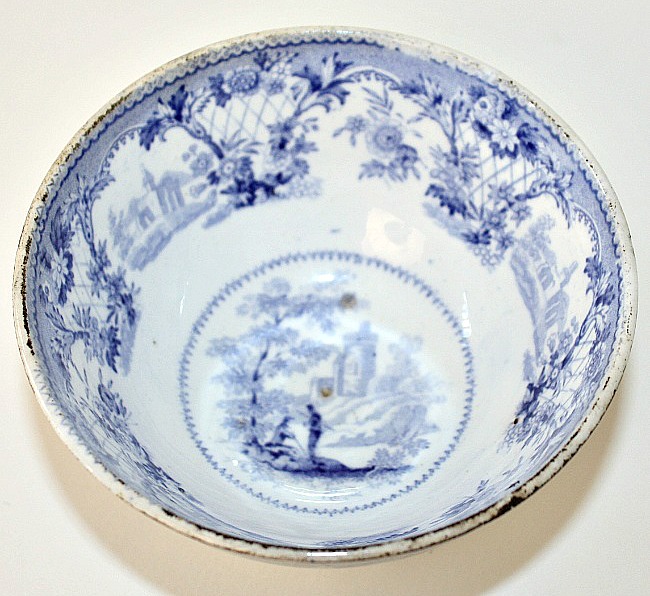
19th-century Staffordshire Tea Bowl
Transferware wasn’t for the wealthy; it was meant to be sold for a few pence each so that a working-class homemaker would be able to purchase one or perhaps two pieces at a time for her household. To produce each pattern, a master pattern was engraved on copper, glazed with color, and then transferred to thin paper. These sections of paper were then applied one by one to a piece of pottery before the piece was put into the kiln. The older the transferware, the more “misses” you will see where the pattern should join at the seams, as workmen were just starting to develop expertise in working with such an exacting task. Many patterns were so complex it took over a month to engrave the copper master sheet.
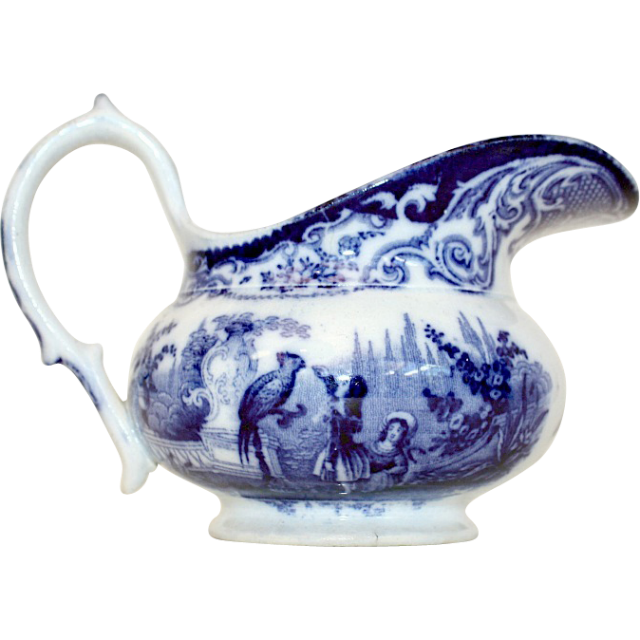
1859 Dutch Maastricht Juvenile Pitcher
Soon factories were producing entire tableware sets, most in romantic patterns featuring a man and woman in lush landscapes. The first transfer pieces (and most popular to this day with collectors) were blue, then black. The other colors weren’t produced much before 1828, when brown, purple, green, and red (or pinkish red) became quite popular. Of all the colors of transferware, yellow was the least in favor and therefore the least produced. It is the most rare and the most costly to acquire today.
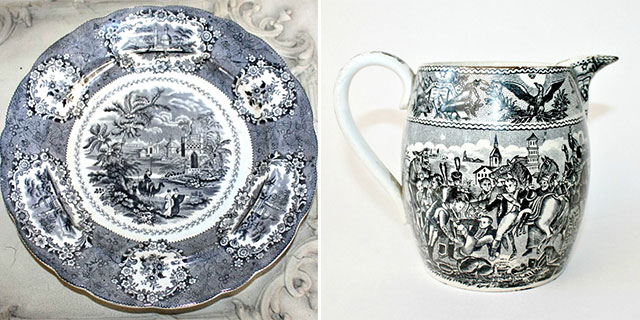
19th-century oriental pattern plate
Pitcher depicting Napoleon during the Napoleonic War.
Most transfer pieces are marked on the bottom with the maker’s mark and often with a pattern name. Some early pieces are unmarked but are just as valuable. Collecting transferware is a wonderful hobby, as there are always new shapes, patterns, and pieces to discover. Some collectors only collect a certain color, and others love to mix and match colors and patterns with abandon! Prices can range from a lucky find at a flea market for under $100 to thousands at an auction house, depending on rarity, size, and who else wants to add a certain piece to their collection! I am particularly enamored with miniature children’s sets like the one shown below; since these were used by children in play, they just did not survive. To find one that is nearly complete is nothing short of a miracle. Collectors sometimes spend years assembling one little set for their collection.
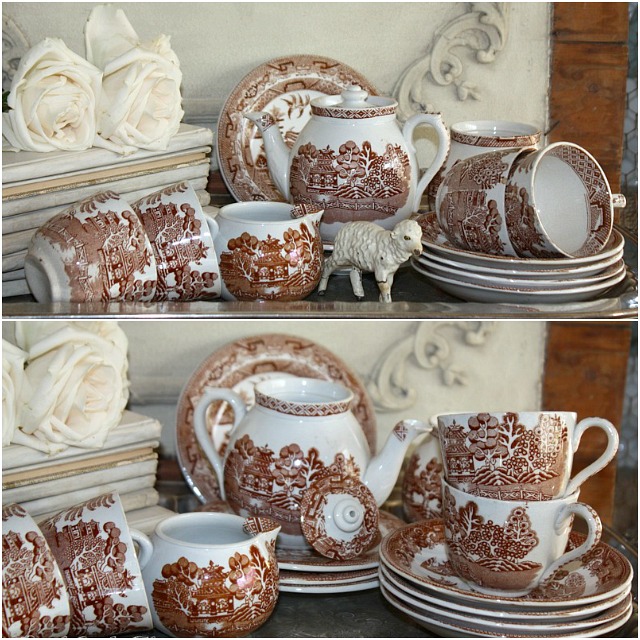
Charming children’s tea set made in Stoke-on-Trent, England.
Every color of transfer-printed earthenware or pottery is lovely—the green plates shown in a little stack below were made in France. Imagine serving guests a holiday meal on these floral plates!
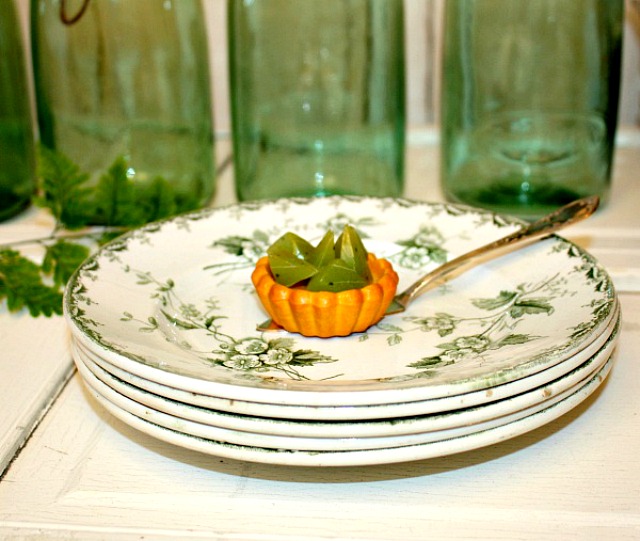
Antique French plates, made by St. Amand et Hammage.
There is quite a large group of collectors who collect pink transfer pieces. Prices for pink transferware are skyrocketing, even for transferware plates and bowls in pink that are not quite antique.
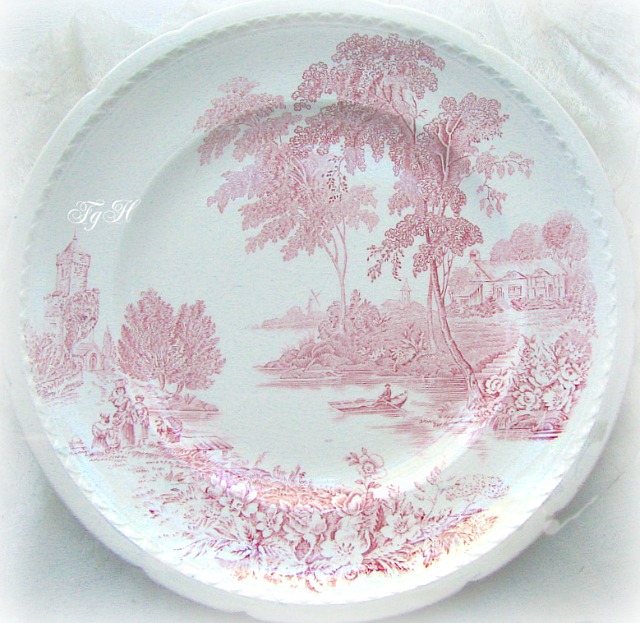
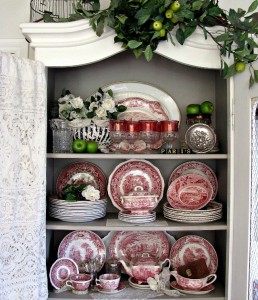 For my own collection, I’ve had to be quite strict with myself. I only keep pieces in red or pink! I don’t really collect any certain pattern or shape, but I mix and match happily. I have a display of some of my favorite pieces in the French armoire in my kitchen, and while I don’t use it daily, I do love to set the table with it for special occasions. One thing I love about collecting the red color is that it mixes so well with blue and black transferware and looks very elegant when layered with all white- or cream-colored plates for a totally different effect!
For my own collection, I’ve had to be quite strict with myself. I only keep pieces in red or pink! I don’t really collect any certain pattern or shape, but I mix and match happily. I have a display of some of my favorite pieces in the French armoire in my kitchen, and while I don’t use it daily, I do love to set the table with it for special occasions. One thing I love about collecting the red color is that it mixes so well with blue and black transferware and looks very elegant when layered with all white- or cream-colored plates for a totally different effect!
Below are a few examples of the range of red and pink transferware patterns in my collection.
Lastly, I want to encourage you, should you have or want to begin a collection of transferware, to use your pieces! I love using the transferware I have for special luncheons or dinners in my home. One of my all-time favorite things to do is to gather a few friends for a holiday, such as Valentine’s Day, and treat them to a lunch or tea at a table set with my mix-and-match pieces.
This table was set for the holidays, again using the same plates and serving pieces. I created a stunning floral centerpiece in one of the teapots using fresh red roses together with asparagus stalks for fun. These pieces have survived for more than 100 years, and they are meant to be used.
The image below is a little fuzzy, but it shows a flower arrangement on my mantel in the living room in a red transferware cup displayed alongside a plate on a Lucite stand. Every piece in a collection of transferware is so decorative it looks wonderful even when displayed all by itself as a work of art—although they truly make a statement when displayed in large groups!
I hope that you have “caught” some of my enthusiasm for transferware so that next time, should you come across a stunning plate, bowl, or teacup, you won’t hesitate to add it to the antiques collections that make your home uniquely yours.
Do you collect antique transferware? I’d love to hear about some of your finds!

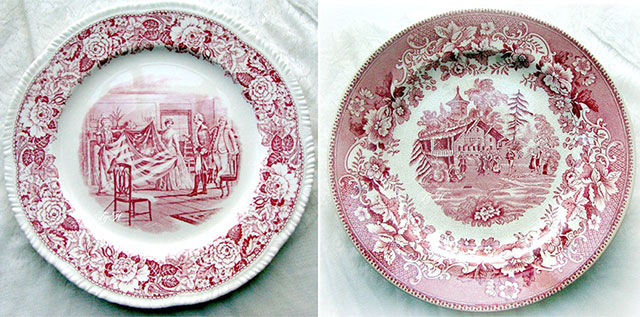
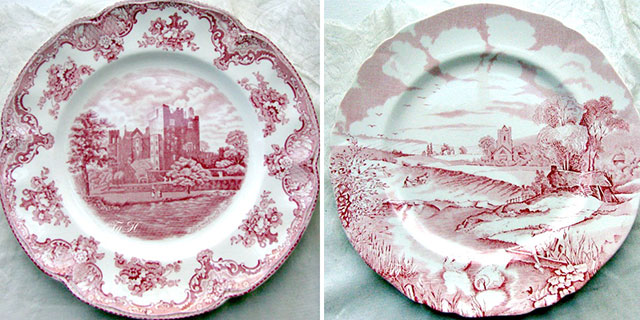
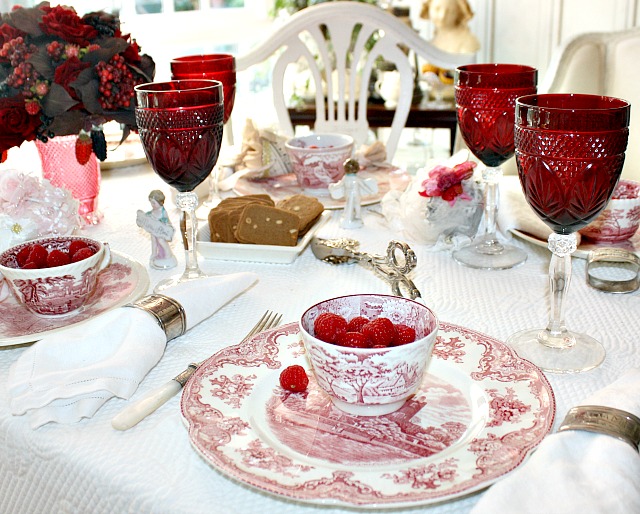
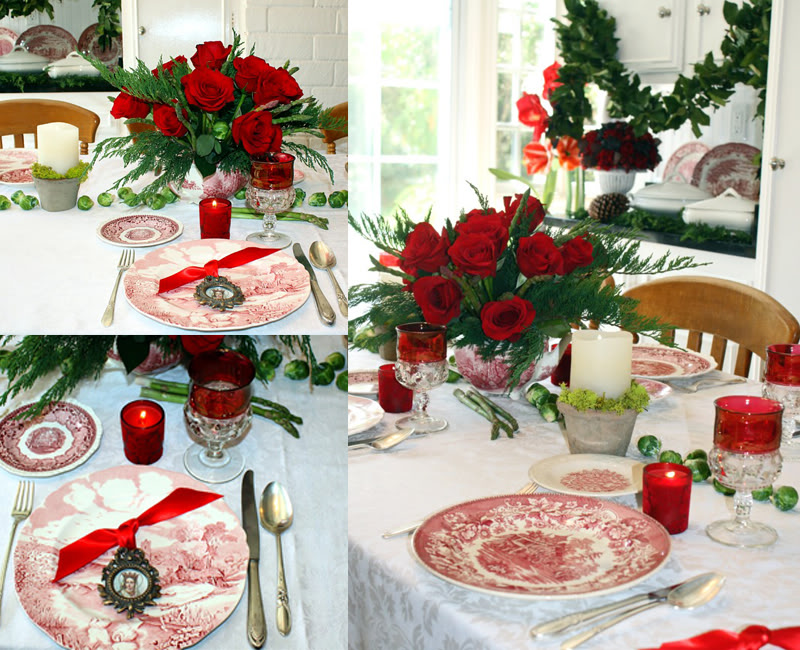

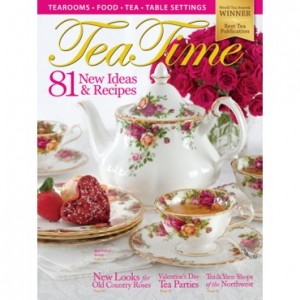
Comments 44
Is an overlap and misaligned flowers on a plate rim’s seam considered a defect? I had never noticed this before.
Hi Lidy! I love my red transferware. I use them in different sizes and shapes arranged on my dining room wall. I also have a couple of teapots. One is Motts Country Life Hand engraved English scenes Permanent Colors Fine Staffordshire ware. Made in England. I was wondering if you know the current value of this piece? I love how you set the table with the roses. I must do that!
I have collected transferware for many years on a limited budget. I have one large meat platter that was my first find about 20 years ago. I paid $20.00 for this piece and would love to know if it is antique or has any monetary value. I have tried to find the potter’s mark on the net, but I have been unsuccessful. It has a lion in the center of a scalloped plate/circle design, surrounded by floral designs, and topped with a small crown. All of this is in pink.Can you help educate me on this piece.I feel that my piece isn’t antique. Doesn’t matter much, I still love the piece that started my collection. My daughter also has a very nice antique blue willow collection. Collecting is contagious. I also collect colored depression glassware mostly in cranberry and forest green. We used my cranberry transfer ware and cranberry depression glass at my mother’s wedding reception with black and white toile tablecloths. It was beautiful. Last night, I purchased an old clear glass punch bowl set. I might need to start thinking about limiting my collecting.
Memrie, I have seen some platters etc. with that mark, if it’s what I think it is. Without seeing it, I can’t say for certain, but you may have a reproduction. Your intuition is most likely correct. Most of the potteries of the old pieces used a backstamp with some kind of name on it, and yours doesn’t appear to have one. Having said that, your $20.00 investment has brought you much joy over the years, and that, truly, is what matters, that you love it and enjoy it!
I think the potters mark you are referring to is Gater Hall and Co and they were in Turnstall,England
I was very lucky and ran across a gentleman that was having a sale of some of his mothers old belongings. I just happened to open a box setting on the ground and in it was a very large set of red and white transferware. The bottom of the dishes do have a stamp on them it has “old English” then below that a crown, GH&Co. I have searched and searched the internet for information on these dishes but have not really had any luck finding any for sale, or any good information on them. One of the large platters is a misprint. They are all in wonderful condition no cracks or breaks just normal crazing, as I did find out that they were made around 1900-1920. I would love to be able to find out more about these dishes if you could possible lead me in the right way. Thank you very much
I have a red willow platter that has “willow” and made in France on the back. It also has a crown and cv initials stamped into it. I can’t find any on the internet about willow made in France. Do I just have an imposter?
Malian, not necessarily. At one time the Willow pattern was so popular, that potteries around the world produced some form of it. I can’t find your particular backstamp, but you most likely have a vintage Willow plate, produced by one of the many factories in France.
What a wonderful, informative post Lidy! I have my great grandmother’s red transfer ware as well as my grandmother’s set of Johnson’s Friendly Village. I had begun collecting a few pieces of modern black transfer ware with Aesop’s Fables on them, but didn’t get too far and now I can’t recall who produced that line…
Thank you, Christine! How lucky that you inherited your grandmother’s transfer ware, I always think it’s so very special when you set your table with dishes that your grandparents loved, too.
I believe it was Spode who produced the modern black Aesop’s Fables transferware. I saw them at a replacement site online
Loved your post. Is Johnson Brothers “English chippendale” considered transfer ware, or does it fall into another category? Thanks!
Carol, English Chippendale was made by Johnson Brothers between 1935 – 1965. Although not antique, it is considered transferware.
I noticed 2 unglazed indentions (brownish spots) in the tea bowl. I have several similar and was going to break them up for a mosaic because I thought the imperfections made them unwanted. They were passed on to me by a very lovely elderly lady. Info is welcome. Always look forward to your posts!
Jean
Thank you Jean. Most of the times unglazed indentions happened during the manufacturing process if your bowls are really old, and that is not considered a “defect” unless the unglazed spots are rather large or disfigure the design.
Thanks for the history, Lidy. One morning my friends and I went to an estate sale and I found a complete set for 8 incl serving pieces of red and white staffordshire transfer ware. I use it often and it makes the prettiest tablescape. I’m also partial to brown and I use that in my decorating. Thanks !
What a lucky find, Thea! I am sure that the tables you set with it are delightful.
I love
The Johnson Bros… Brown. Did not know it was transferware. Do all have lead?? We use ours every day.
I so love reading your Blog…. And learn so much reading it (and blogs fr others).
I apologize I said Johnson Bros “brown” it is old scenes (winter) and I use every day with my white dishes. It is “the friendly village” and so homey.
I have China that I use for special occasions, but love these village scenes…. And enjoy them every day. Hopefully they are not too dangerous.
I am going to watch for the other transfer ware patterns you have discussed today.
Thanks again!
Colleen, I love Friendly Village, you are right, it is cozy and homey! I am sure that you set a beautiful table when using your transferware mixed with white dishes.
I have the red transfer ware which was my Grandmother’s. I love it and mix it with all of my own china.
Just an FYI…the earlier pieces do have lead in them, particularly the older pieces. Check the back of the plate: if it says “England” (1880-1921) it most likely had some lead; if it says “Made in England” (1921-present) it most likely does not. I use Allerton’s Blue Willow on an every day basis and have not had a problem. I also have lots of B&W but do not use that for food. I have collected for 30 years (maybe more) and still just love the stuff!
I follow you as well as The Ribbon in My Journal. I was going to ask how transferware was made, etc. and you gave me all the answers I needed. Thanks for the education and the inspiration. I will be looking for transferware from now on.
Thank you Nancy! I hope you are able to find some lovely pieces. Lidy
I have become smitten with Red and White Transferware! It all happened by accident after the open shelf where I store our ironstone crashed down. As a replacement to accent our dinner plates, I decided to start collecting. I thought I would mix and match but I have grown fond of Bristol Royal Ducal. I keep sneaking pieces in so hubby doesn’t notice. 🙂
What a lovely story of ironstone transfer ware! Although I admire the red/pink, I nurture a strong preference for blue, especially the Blue Willow and a rare Staffordshire find. Blue Willow not only is our choice for all meals but also serves a decorative purpose lined up on shelves, along the mantel, even over a doorway, not to mention the tea table laid with a tray. Did I mention the collection of tea pots in Blue Willow? I really don’t need any more yet I still collect. Can’t resist.
Blue and white runs in my veins I think. Love it.
I love all the colors. I have the blue and white and green and white. I found in an antique store here in Natchez, MS a green and white set that has many pieces, even the salt cellars and the bone dished, 2 platters and 2 soup tourens I love to use that set for Christmas and Valentine’s Day. I have many pieces of the blue and white and decorate with it in my front parlor and in kitchen and really all over my home. Thank you. If you have a chance please look at my website, I think you may enjoy it. magnoliacottagebandb.com
Love your post on transferware — I’ve collected it for years and used it regularly until I did a lead test and discovered it had lead in it. I’d love to start using it again, but reluctant to because of the lead finding — what do you suggest?
Barbara, that is always a lively discussion amongst collectors. I suggest you use google and pose that question, there are some answers to the question from the FDA that might interest you. If you are at all worried, I suggest using it for display only.
Thank you so much! It’s taken me so long to collect, I hate to give it up.
You could use it under clear glass plates.
That’s an idea — thanks!
I can’t possibly put my excitement into words! Ohmygoodness, you have answered SO many questions I have had about transferware. I have been wanting to begin collecting red and/or brown and will probably work on both now that I have gained confidence from your tutorial. I love that you mix all patterns of red and plan to do the same myself. Thank you, Lidy! Have a wonderful day!
Thank you Donna! I am excited for you that you are going to begin a collection of red and/or brown transfer ware {it IS addicting!} it’s a wonderful hobby, and something you and your family and friends will enjoy at your tables
for many many years.
I’m very fond of transfer ware too; I have my mother’s full set of Pink Tower Spode, a set of teal plates and soup plates that were a gift and several miscellaneous pieces in various shades of blue and also brown. My recent success story was picking up three Pink Tower salad plates at an auction for only a few dollars; no one seemed to be at all interested in them.
How can you tell if it’s transferware?
Grace, most transferware is fairly easy to spot. If the pattern repeats itself, is not hand painted, and fairly ornate like the examples in the blog post, it’s transfer ware. The older pieces actually will have very faint lines where the transfer paper pattern was “matched up”, they almost look like very tiny cracks in the pattern.
Thanks for the information.
I have been searching for transferware in brown ( to use for the fall season ). I do have salad plates with a majestic “turkey” in the center design – a lucky find from “Replacements” . My quest will continue …
I love the red/pink as well and would use it for Christmas,Valentine’s Day and July 4th .
If I continue to buy more china , I may need a larger home to support my “habit” !
I so enjoyed your post .
Thank you !
Christine, I love the brown transferware too! (To be honest, I’ve never met transferware I didn’t love!) I laughed at your “may need to buy a larger home to support my habit” as that is what my husband says. It’s so wonderful to know that so there are so many fellow transferware lovers out there…kindred spirits!
Maryanne, I love hearing that your Transferware is loved and used! That you have inherited it, and will pass it on to your daughter makes it all the more special.
I have black Creil transfer ware my dad traded cigarettes for during WWII and sent home to my mom.
I love transferware and I have quite a lot of my mother’s collection. She had the Johnson Bros. Castle pattern as her “best” china and I have the entire set including serving bowls, gravy boats and square and round dessert plates. It dates to the late 1940’s. She also had a lot of antique blue transfer which I also have. I use all of it, especially the pink set, around the holidays. It will all be passed on to my daughter who loves it also.